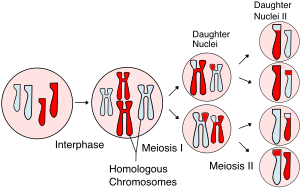Meiosis facts for kids
Meiosis is a special way cells divide. It's different from mitosis, which is how most body cells make copies. In meiosis, the new cells end up with only half the usual number of chromosomes. Think of it as a "reduction division" because the chromosome number is cut in half. This process is super important for sexual reproduction and helps create variety in living things.
When a sperm cell joins with an egg cell, it's called fertilization. Sperm and egg cells are special cells called gametes, or sex cells. These gametes are haploid, meaning they have just one set of chromosomes. A normal body cell, called a somatic cell, is diploid and has two sets. When a sperm and egg combine, they restore the full, diploid number of chromosomes.
For humans, our body cells have 46 chromosomes. We get 23 from our mom and 23 from our dad. So, our body cells have two copies of each chromosome. Sex cells (sperm or egg) have 23 chromosomes. This is why meiosis is so important: it makes sure the sperm and egg have half the chromosomes, so when they join, the new baby gets the correct total number.
A karyotype is like a map of all the chromosomes in a eukaryote species. Scientists study karyotypes to learn about the chromosomes inside cells. All living things that reproduce sexually, even some tiny single-celled organisms, use meiosis. But very simple life forms like archaea or bacteria don't use meiosis; they just split in two.
Contents
How Meiosis Works
Meiosis happens in two main steps: Meiosis I and Meiosis II.
Meiosis I: First Division
The first division of meiosis is important because it allows for crossing over. Like mitosis, meiosis has different phases: prophase, metaphase, anaphase, and telophase.
- Prophase I
- The chromosomes become easy to see. The protective covering around the cell's control center (the nucleus) disappears. Tiny structures called centrioles start making long fibers that grab onto the chromosomes.
- At this point, each chromosome has already made a copy of itself. These copies are called sister chromatids and they are joined together. Matching chromosomes pair up, forming a group of four chromatids. Here, pieces of DNA can swap between the matching chromosomes. This swapping is called recombination and it mixes up the genetic information.
- Metaphase I
- The pairs of matching chromosomes line up neatly in the very middle of the cell.
- Anaphase I
- The matching chromosome pairs are pulled apart. Half go to one side of the cell, and the other half go to the opposite side. In humans, 23 chromosomes go to each side.
- The cell then starts to divide into two separate cells.
- Telophase I
- The two new cells completely separate. A new protective covering forms around the chromosomes in each cell. The chromosomes become less visible. Each of these new cells now has 23 chromosomes.
Meiosis II: Second Division
Before the second division, the two cells from Meiosis I get ready. Both of these cells will go through Meiosis II.
- Prophase II
- The chromosomes become visible again. The nuclear covering disappears, and the centrioles start forming new fibers.
- Metaphase II
- The chromosomes line up along the middle of each cell.
- Anaphase II
- This time, the sister chromatids (the two copies of each chromosome) are pulled apart. One copy goes to one side, and the other copy goes to the opposite side.
- The cells then start to divide again.
- Telophase II
- The cells fully divide. New nuclear coverings form. This process creates four brand new cells. Each of these four cells has a unique mix of DNA.
In males, all four of these new cells become sperm cells. In females, only one of the four cells becomes a mature egg cell. The other three usually get reabsorbed by the body.
When Meiosis Goes Wrong
Sometimes, meiosis doesn't happen perfectly. When this occurs, a person might end up with too many or too few chromosomes. This can lead to certain health conditions. Here are some examples:
- Down syndrome: This happens when there's an extra chromosome 21.
- Patau syndrome: This is caused by an extra chromosome 13.
- Edwards syndrome: This occurs when there's an extra chromosome 18.
- Klinefelter syndrome: Males with this condition have extra X chromosomes, like XXY.
- Turner syndrome: Females with this condition are missing one X chromosome, like XO.
- Triple X syndrome: Females with this condition have an extra X chromosome.
- XYY syndrome: Males with this condition have an extra Y chromosome.
Images for kids
See also
 In Spanish: Meiosis para niños
In Spanish: Meiosis para niños






